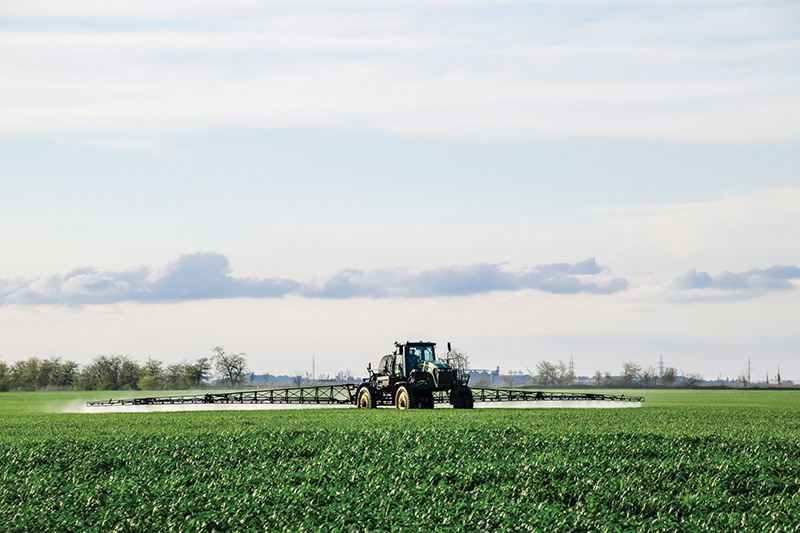The efficient use of fertilizers is crucial to healthy crop production. Courtesy Photo
GUELPH – Winter is coming to an end and farmers are poised to begin another planting season.
However, there are many questions that farmers do not feel they have the answer to when it comes to ensuring they will be able to farm as usual.
Farming in a global marketplace has never been easy.
The agricultural industry, to a great extent, has to depend on its government to support them and be a voice for them in a room filled with increasing loud global voices.
The Grain Farmers of Ontario, (GFO), has asked its members to raise their voice along with theirs to remind the federal government that the agricultural industry need their support globally and at home.
There are several issues that are of significant concern for Ontario farmers.
The Grain Farmers of Ontario represent 28,000 farmers in Ontario who grow barley, corn, oat, soybean and wheat.
In a response to the Russian invasion of Ukraine, one of the sanctions put on Russia by the Canadian government was a tariff on fertilizers. Russia up until then was one of the bigger exporters of fertilizers needed every year by Canadian farmers.
Close to $34 million in tariffs was collected from farmers on Russian fertilizer imports in 2022.
Farmers were soon seeing the addition in fertilizer they were ordering, but also noticing a tariff fertilizer upcharge on product they ordered before the sanctions had been applied. Since then, the government has agreed, with encouragement from the agriculture industry, that the tariff placed on a product already bought and paid for was unfair. They agreed to return the funds from increased tariffs to the agriculture industry but not to individual farmers.
Scott Fife a director with the GFO said, “The tariff was applied to fertilizer that was already bought, and paid for by Canadian importers. It was too late for anyone to make a change at that point, being so close to spring planting, so we felt it was unfair, and that money should be returned to the farmers who paid it.”
The tariff is still in place in 2023. Canada is the only G7 country with the tariff still in place and the UN has called for countries to lift any barriers to food production, including tariffs on fertilizer.
Farmers would also like to know when the tariffs might end.
“The Ontario Grain Farmers would like that tariff removed,” said Fife. “We would also like the money we have already paid from last year to be returned.”
Fife believes returning the tariff’s collected is not an impossible task.
He said every farmer who paid the tariff last year has a receipt for it.
“The GFO has been fairly consistent for over a year now, and that is what we are asking,” said Fife.
“They have indicated recently they are looking into ways to get this money back into farmers hands, but not necessarily directly back to those who paid it, which is what we would prefer.”
Another question asked by the GFO focuses on the supply of fertilizer available to Ontario grain farmers. Is there a way for the government to support them by finding a way to ensure a farmer’s access to fertilizer now and in the future?
“Russia is a big player on the world stage when it comes to nitrogen and phosphate fertilizers. We have other countries such as China that have restrictions on phosphate, so that is limiting the world’s supply. And then we have the tariff placed on the Russia supply, making it more difficult to ensure that farmers will have everything they need going forward.”
More than half of farmers involved in a survey by GFO reported being asked to pay a surcharge on fertilizer. This was the result of the tariff on fertilizer.
For the 2022 growing season, more than one in six farmers surveyed experienced a fertilizer supply shortage. The survey also indicated that in 2022 there were farmers who experienced shortages in fertilizer supplies.
Fife said, “The world price for fertilizer has been very volatile in the last year.”
He said the reasons for a volatile market can involve supply chain issues, weather, and the marketplace in general, however adding government policies to the list of uncontrollable challenges to the agriculture industry makes the situation worse.
“We do not need that extra pressure on the fertilizer price.”
Despite ongoing strategies to use cover crops and efficiencies to reduce the need for fertilizers, they are still crucial to a farmer’s plans.
A press release from the GFO stated: “Farmers work on very thin margins for the businesses we run that support our families. We need to produce an abundant, healthy crop and to do that, we need to provide plants with nutrients. We are now over one year into the tariffs on fertilizer that was downloaded as a cost to farmers. We are the only G7 country to keep fertilizer tariffs as other countries prioritized food production. While we are encouraged by the federal government’s commitment to return fertilizer tariff money, we want to re-state that the money needs to be returned to the farmers who paid the cost,” said the chair for Grain Farmers of Ontario, Brendan Byrne.
A House of Commons Finance Committee pre-budget report suggested there might be other options available to the government to help farmers.
The report featured recommendations for a food security program intended to support food producers affected by the federally imposed tariffs related to Russian fertilizer.
The report also looked at the idea of creating a special assistance program that targets the agricultural industry to help with impacts from inflation on the financial health of the agricultural businesses.
“This is a good indicator that Members of Parliament from all parties understand the hardships these tariffs have created and the impact of inflation on the rising costs of inputs and equipment. We hope that any new programs address the needs of individual farmers who had to make the tough choices and who took the risk to produce crops despite these increased costs,” said Crosby Devitt, CEO, Grain Farmers of Ontario.
A survey from RealAgriStudies shone a light on significant changes that have now become a new reality for many farmers.
The survey showed:
- Approximately half of farmers indicated that they used less fertilizer in 2022 because of the increased price of fertilizer
- 25 per cent indicated they made changes to their crop rotation
- 25 per cent of farmers indicated they will be making changes to their 2023 crop rotation, with over half indicating a likelihood they will grow more soybeans
- 17 per cent of farmers have indicated their retailer has notified them of potential fertilizer shortages
GFO is making it easy for farmers and consumers to let the government know how they feel about this situation.
Farmers can go to www.grainforgood where they will find a button named “Take Action” that will take them to other buttons that will allow them to fill out a blank email that can be sent to their local member of parliament.













